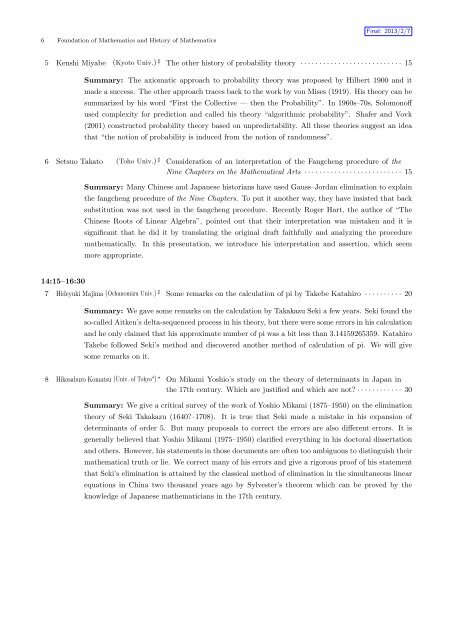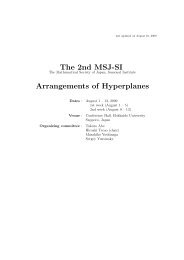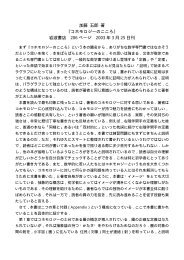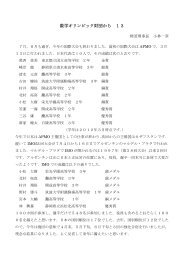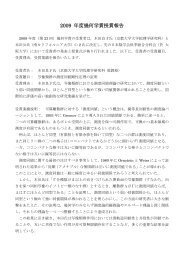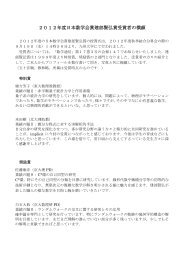Titles and Short Summaries of the Talks
Titles and Short Summaries of the Talks
Titles and Short Summaries of the Talks
You also want an ePaper? Increase the reach of your titles
YUMPU automatically turns print PDFs into web optimized ePapers that Google loves.
6 Foundation <strong>of</strong> Ma<strong>the</strong>matics <strong>and</strong> History <strong>of</strong> Ma<strong>the</strong>matics<br />
Final: 2013/2/7<br />
5 Kenshi Miyabe (Kyoto Univ.) ♯ The o<strong>the</strong>r history <strong>of</strong> probability <strong>the</strong>ory · · · · · · · · · · · · · · · · · · · · · · · · · · · 15<br />
Summary: The axiomatic approach to probability <strong>the</strong>ory was proposed by Hilbert 1900 <strong>and</strong> it<br />
made a success. The o<strong>the</strong>r approach traces back to <strong>the</strong> work by von Mises (1919). His <strong>the</strong>ory can be<br />
summarized by his word “First <strong>the</strong> Collective — <strong>the</strong>n <strong>the</strong> Probability”. In 1960s–70s, Solomon<strong>of</strong>f<br />
used complexity for prediction <strong>and</strong> called his <strong>the</strong>ory “algorithmic probability”. Shafer <strong>and</strong> Vovk<br />
(2001) constructed probability <strong>the</strong>ory based on unpredictability. All <strong>the</strong>se <strong>the</strong>ories suggest an idea<br />
that “<strong>the</strong> notion <strong>of</strong> probability is induced from <strong>the</strong> notion <strong>of</strong> r<strong>and</strong>omness”.<br />
6 Setsuo Takato (Toho Univ.) ♯ Consideration <strong>of</strong> an interpretation <strong>of</strong> <strong>the</strong> Fangcheng procedure <strong>of</strong> <strong>the</strong><br />
Nine Chapters on <strong>the</strong> Ma<strong>the</strong>matical Arts · · · · · · · · · · · · · · · · · · · · · · · · · · 15<br />
14:15–16:30<br />
Summary: Many Chinese <strong>and</strong> Japanese historians have used Gauss–Jordan elimination to explain<br />
<strong>the</strong> fangcheng procedure <strong>of</strong> <strong>the</strong> Nine Chapters. To put it ano<strong>the</strong>r way, <strong>the</strong>y have insisted that back<br />
substitution was not used in <strong>the</strong> fangcheng procedure. Recently Roger Hart, <strong>the</strong> author <strong>of</strong> “The<br />
Chinese Roots <strong>of</strong> Linear Algebra”, pointed out that <strong>the</strong>ir interpretation was mistaken <strong>and</strong> it is<br />
significant that he did it by translating <strong>the</strong> original draft faithfully <strong>and</strong> analyzing <strong>the</strong> procedure<br />
ma<strong>the</strong>matically. In this presentation, we introduce his interpretation <strong>and</strong> assertion, which seem<br />
more appropriate.<br />
7 Hideyuki Majima (Ochanomizu Univ.) ♯ Some remarks on <strong>the</strong> calculation <strong>of</strong> pi by Takebe Katahiro · · · · · · · · · · 20<br />
Summary: We gave some remarks on <strong>the</strong> calculation by Takakazu Seki a few years. Seki found <strong>the</strong><br />
so-called Aitken’s delta-sequenced process in his <strong>the</strong>ory, but <strong>the</strong>re were some errors in his calculation<br />
<strong>and</strong> he only claimed that his approximate number <strong>of</strong> pi was a bit less than 3.14159265359. Katahiro<br />
Takebe followed Seki’s method <strong>and</strong> discovered ano<strong>the</strong>r method <strong>of</strong> calculation <strong>of</strong> pi. We will give<br />
some remarks on it.<br />
8 Hikosaburo Komatsu (Univ. <strong>of</strong> Tokyo ⋆ ) ∗ On Mikami Yoshio’s study on <strong>the</strong> <strong>the</strong>ory <strong>of</strong> determinants in Japan in<br />
<strong>the</strong> 17th century. Which are justified <strong>and</strong> which are not? · · · · · · · · · · · · 30<br />
Summary: We give a critical survey <strong>of</strong> <strong>the</strong> work <strong>of</strong> Yoshio Mikami (1875–1950) on <strong>the</strong> elimination<br />
<strong>the</strong>ory <strong>of</strong> Seki Takakazu (1640?–1708). It is true that Seki made a mistake in his expansion <strong>of</strong><br />
determinants <strong>of</strong> order 5. But many proposals to correct <strong>the</strong> errors are also different errors. It is<br />
generally believed that Yoshio Mikami (1975–1950) clarified everything in his doctoral dissertation<br />
<strong>and</strong> o<strong>the</strong>rs. However, his statements in those documents are <strong>of</strong>ten too ambiguous to distinguish <strong>the</strong>ir<br />
ma<strong>the</strong>matical truth or lie. We correct many <strong>of</strong> his errors <strong>and</strong> give a rigorous pro<strong>of</strong> <strong>of</strong> his statement<br />
that Seki’s elimination is attained by <strong>the</strong> classical method <strong>of</strong> elimination in <strong>the</strong> simultaneous linear<br />
equations in China two thous<strong>and</strong> years ago by Sylvester’s <strong>the</strong>orem which can be proved by <strong>the</strong><br />
knowledge <strong>of</strong> Japanese ma<strong>the</strong>maticians in <strong>the</strong> 17th century.


